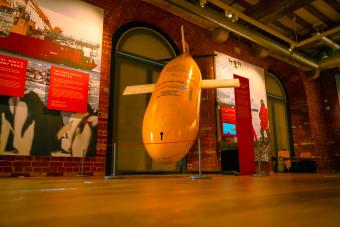The extraordinary tale of HMS Challenger’s expedition – the daring three-year scientific odyssey led by the Royal Navy 150 years ago that forever changed our understanding of the Earth’s ocean – is the fascinating, and timely, focus of a brand-new exhibition Worlds Beneath the Waves opening at The National Museum of the Royal Navy, Portsmouth Historic Dockyard.
The exhibition, in partnership with the National Oceanography Centre (NOC), includes the chance to get up close and personal with Boaty McBoatface and to see specimens from NOC’s Discovery Collections.
With climate change and the state of the world’s ocean dominating global headlines, Worlds Beneath and the Waves traces the impact of Challenger’s voyage and reveals how the Royal Navy is still at the forefront of scientific research centred on our ocean.
On 21 December 1872, HMS Challenger a 69-metre-long Pearl-class corvette converted into a survey ship set sail from Portsmouth with a crew of approximately 240 including six civilian staff, scientists and artist on a scientific expedition to explore and survey our ocean. Their collective findings shattered long-held beliefs, challenging conventional wisdom and propelled marine science into a new era of enlightenment.
In partnership with NOC the Royal Navy is still collecting data through the deployment of ships such as; HMS Protector, a purpose-built ice patrol ship that works principally in the polar regions; Autosubs – the most famous of which is Boaty McBoatface, a version of which makes an appearance in the exhibition; underwater sliders and remotely operated vehicles (ROVs) which helps us understand the changing ocean.
Diana Davies, Head of Conservation at The National Museum of the Royal Navy said: “HMS Challenger's legacy extends far beyond its famous voyage. The expedition inspired generations of ocean scientists and the data the expedition generated is still being used to help us understand the wonders of the deep sea, even today.
“It’s never been more important to understand the role the ocean plays in the future of our planet, and we’re so excited to welcome visitors to this new exhibition on a journey of discovery that takes you through the very beginnings of true oceanography, to the work of the modern navy and the findings of contemporary marine scientists at the forefront of their field.”

Alice Kloker, Stakeholder Engagement Manager at NOC said: “We are delighted to be partnering with The National Museum of the Royal Navy to help bring to life current ocean science, whilst showcasing the importance of the rich historical foundations it is built on. So much of our ocean is yet to be discovered and its vital role in regulating our climate, weather and ecosystems is often overlooked. Through our work at NOC, we improve knowledge of the ocean and how it influences and is influenced by people. This inspiring exhibit is an excellent opportunity to raise awareness of the challenges our ocean faces, the knowledge needed inform solutions, and role emerging technologies play in delivering these answers.”
The scientific impact of the Royal Navy’s Challenger expedition cannot be underestimated. The team of scientists made astounding discoveries including nearly 4,700 plant and animal species specimens and the Mariana Trench, which at nearly four miles deep is the deepest oceanic trench on Earth.
The Challenger Expedition laid the foundation for modern oceanography, forever transforming our perception of the world’s ocean. It revolutionised our understanding of marine biology and the scientific findings, that run to 50 volumes of scientific data, is still at the heart of modern-day research.
This exhibition features specimens collected during the expedition; the voices of the men and women of the modern crews undertaking this vital work and provides opportunities to explore scientific ideas through interactive exhibits and includes the chance to create an AI-generated sea creature.
Challenger Expedition
Led initially by the intrepid Captain George Nares, HMS Challenger embarked on its monumental journey in 1872, equipped with a team of scientists and state-of-the-art equipment. Their mission was to uncover the secrets of the deep sea and unlock the mysteries that lay beneath the waves.
For nearly four years, Challenger charted a course of nearly 69,000 nautical miles across the globe, traversing uncharted waters and braving treacherous storms. Equipped with ingenious instruments, the team meticulously collected samples, measured water properties, and recorded vital data about marine life. They unveiled an array of bizarre and wondrous creatures that inhabited the darkest depths of the ocean, discovering the Mariana Trench, the deepest point on the planet, along the way.
Worlds beneath the Waves is located in the National Museum of the Royal Navy Portsmouth and opens at 10.00hrs on Saturday 16 September.

